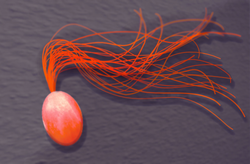| Thermococcales | |
|---|---|
 | |
| Pyrococcus furiosus | |
| Scientific classification | |
| Domain: | Archaea |
| Kingdom: | Methanobacteriati |
| Phylum: | Methanobacteriota |
| Class: | Thermococci |
| Order: | Thermococcales Zillig et al. 1988 [1] |
| Family | |
The Thermococcales are an order of microbes within the class Thermococci. [2] The species within the Thermococcales are used in laboratories as model organisms. [3] All these species are strict anaerobes and can ferment sugars as sources of carbon, but they also need elemental sulfur. [4]